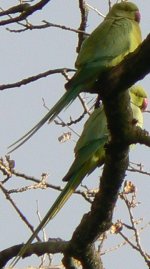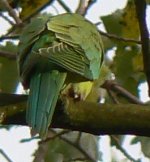cut & paste from BWPi piece on R N Parakeets, hope this answers your questions
'Adult Male
Forehead, lores, ear-coverts, and cheeks bright yellowish-green with faint black line from nostril to front of eye; crown, nape, and back of ear-coverts and hindcheeks bright yellowish-green, extensively tinged sky-blue or pale lavender-blue on feather-tips, forming solid pale blue patch on hindcrown and nape narrowing to lower hind-cheeks when plumage fresh, but much yellow-green of feather-bases exposed and blue almost absent when plumage worn. Band bordering base of lower mandible and along bare chin black, widening on black throat. Narrow collar round neck pink-red on hindneck, black bordered below by pink-red on sides of neck, black on foreneck where widening to throat. Upperparts including upper wing-coverts bright green, brightest on back and rump, slightly bluish just below pink-red band of hindneck, on tertial coverts, and on outer webs and tips of median and greater coverts; green of upperparts duller when plumage worn. Under-parts including axillaries and lesser and median under wing-coverts yellowish-green, less bright and shiny than on face and cheeks, slightly tinged grey on chest, sides of breast, and upper flanks, more greenish-yellow on lower flanks, thighs, and under tail-coverts. Central pair of tail-feathers (t1) pale bluish-green, grading to pale turquoise on distal half or more; t2 pale bluish-green on outer web, yellowish-green on inner, t3–t6 bright yellowish-green on outer web, pale greenish-yellow on inner; all tail-feathers with contrasting horn-black shaft, narrow pale yellow fringe at tip, and with pale yellow undersurface with slight dusky distal suffusion. Flight-feathers, greater upper primary coverts, and bastard wing dark green, contrasting with paler green upper wing-coverts; shafts black, inner webs of flight-feathers broadly bordered dull black; inner web of p10 largely black and outer web dark bluish-green to cerulean-blue; tips of outer webs of secondaries, inner webs of primaries, and outer webs of (p7–)p8–p9(–p10) narrowly edged pale yellow or yellowish-white. Undersurface of primaries and greater under primary coverts greyish-black, contrasting with yellowish-green of remainder of underwing.
Adult Female
Like adult ♂, but entire head and neck green, brightest and with faint dark loral line on face, slightly duller and similar to remainder of upperparts on crown, nape, and neck; some greenish-yellow of feather-bases sometimes exposed by wear. No blue on head or black on throat and no pink-red and black collar but usually a shiny emerald-green collar just visible and occasionally a faint dark green-grey bar on sides of neck, mainly caused by wear.
Nestling
Entirely naked, except for a few white hairs present at hatching, soon disappearing (Harrison 1975).
Juvenile
Like adult ♀, but green of head and body with slightly more yellowish tinge; tips of flight-feathers and greater upper primary coverts and inner webs of primaries narrowly edged yellow, these edges wider than those present in fresh adult, up to 1 mm; tail shorter than adult.
First Adult
Like adult ♀ and difficult to distinguish, but usually retains some scattered worn juvenile flight-feathers with traces of rather wide yellow edges; tail on average shorter than in adult. Adult head markings in ♂ acquired after complete first post-breeding moult in 3rd calendar year.
Bare parts
Adult
Iris pale yellow or yellowish-white. Bare skin round eye pink-yellow to orange. In borealis, bill coral-red, lower mandible sometimes partly marked black; in other races, lower mandible entirely black; tip of upper mandible black in krameri and slightly so in parvirostris. Leg and foot greenish-grey or greenish-slate.
Nestling
Iris bluish. Bill yellowish, changing to red before fledging. Bare skin pinkish with some faint blue patches. Leg and foot pink or whitish-pink.
Juvenile
Iris greyish-white. Bill coral-pink with pale tip. Leg and foot grey. (Ali and Ripley 1969; Harrison 1975; Forshaw 1978; BMNH.)'






